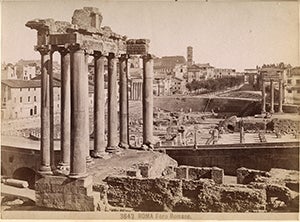Summer armchair travels continue with two perspectives on visits to Rome. In reading these accounts, I’m reminded of the lasting effect that travel to new places can have on the mind and spirit.
A reminiscence by Rose Hawthorne Lathrop, of a visit as a young girl with her mother, probably at the turn of the 19th and 20th centuries.
Rose Hawthorne Lathrop (1851-1926) was born in Lenox, Massachusetts to Nathaniel Hawthorne and Sophia Peabody. Lathrop received her education in London, Paris, Rome and Florence. She married author George Parsons Lathrop in 1871, and both converted to Roman Catholicism in 1891. After the death of their son, Francis, at the age of five, Lathrop separated from her husband in 1895. She attempted unsuccessfully to follow in her father’s footsteps as a writer. Eventually Lathrop discovered her true calling in caring for others. She founded St. Rose’s Free Home for Incurable Cancer in New York City, established under the auspices of the Dominican Sisters of Hawthorne, a religious community created by Lathrop. St. Rose’s ceased operations in 2009. In 2003, Edward Egan, Cardinal Archbishop of the Archdiocese of New York approved a movement for Lathrop’s canonization and she was given the titled “Servant of God” in the Catholic Church.
Here are excerpts from the manuscript about her visit to Rome:
Arrival:
We entered Rome after a long, cold, wet journey that was enough to disillusion me…It was a solemn-faced carriage load that shook & shivered into Rome that night. My next keen remembrance is of a perpetual rice pudding…We used to say: “Oh, this everlasting rice pudding!” No one knows how much such a simple thing can do; but it can make Rome tame.” (p.1)
Colosseum:
The great arches of triumph…seemed to me too premeditated & unnecessary. Not so the Colisseum [sic], haunted by wild beasts, [where] lions leapt in hobgoblin array from the cavernous entrances… (p.3)
The circular form of the ruin is full of eloquence – what would be grace in a smaller structure is tragedy in so immense a sweep, which melts into vagueness, or comes momentously upon you, or swirls before you in a retreating curve…(p.4)
Tombs
The tomb of Caecilia Metella, & other tombs beyond the walls, gave me my first impression of death that really was death...I believe I never should have been half an heretic for some years of my life, if it had not been for the effects of those down-dragging Roman tombs…(p.4)
(Theodore Maynard Papers, GTM.Gamms329, Box 2, Folder 10.)

Photograph of the Roman Forum and Colosseum reproduced from Transformation, or, the Romance of Monte Beni, Volume One (Leipzig: B. Tauchnitz, 1860). Click to enlarge.
In contrast, here is an account written by a mid-20th century traveler, Ned O’Gorman, when he visited Rome in 1956:
There will never be any way to explain Rome. Christ and Nero, Pallas Athene and Saint Peter meet there. The spirits of all the gods have equal rights in Rome, though one may love one God more than another. No God is fool enough to take it all for his own. It is an eternal city and eternal is an adjective for all the gods to share. Rome is a surfeit of everything: children, soldiers, sailors, monks, women, cats, diplomats, cars, tourists, students, Popes, saints, demons, martyrs, princes, pretenders, palaces, beggars, movie stars, beatniks, poets, painters, and mothers. Rome has nothing to do with time; each epoch still possesses the city, each mystery cult, each sacred sentiment and myth, weaves in and out of light and darkness…(pp.15-16)
I love the impenetrable forms of her interior life and the secrets of the streets that turn on themselves and open like shelves of dark colored glass on fountains and plains of crested shadows. Nothing in Rome grows worn with remembrance. When I return to a market, to a flight of steps, to a courtyard, to a hillside, to a junction of a temple and its enfolding sacral light, a new order of feeling visits me… (p.146)
Rome leaps in and out of time. Light, water, stone, air, and flowers cloister the nerves and burn through to the soul proclaiming the triumph of beauty and man over the demon and death. The cloister envelopes the imagination. The vortex leaps into silence. The mind is pushed against the tides of feeling, is swept away by a fancy of, say, Borromini or Bramante, who took stone and bent into a grain of air, angelic and aquatic, that sweeps the flesh and mind with a lush, erotic joy. Rome, the prismatic barque (p.147)
(Ned O’Gorman papers 4, GTM050910, Box 1, Folder 96)
--Lisette Matano, Manuscripts Archivist
July 12, 2017
